The Master's Apprentice
A profile of Nintendo’s "other Miyamoto", Yoshiaki Koizumi
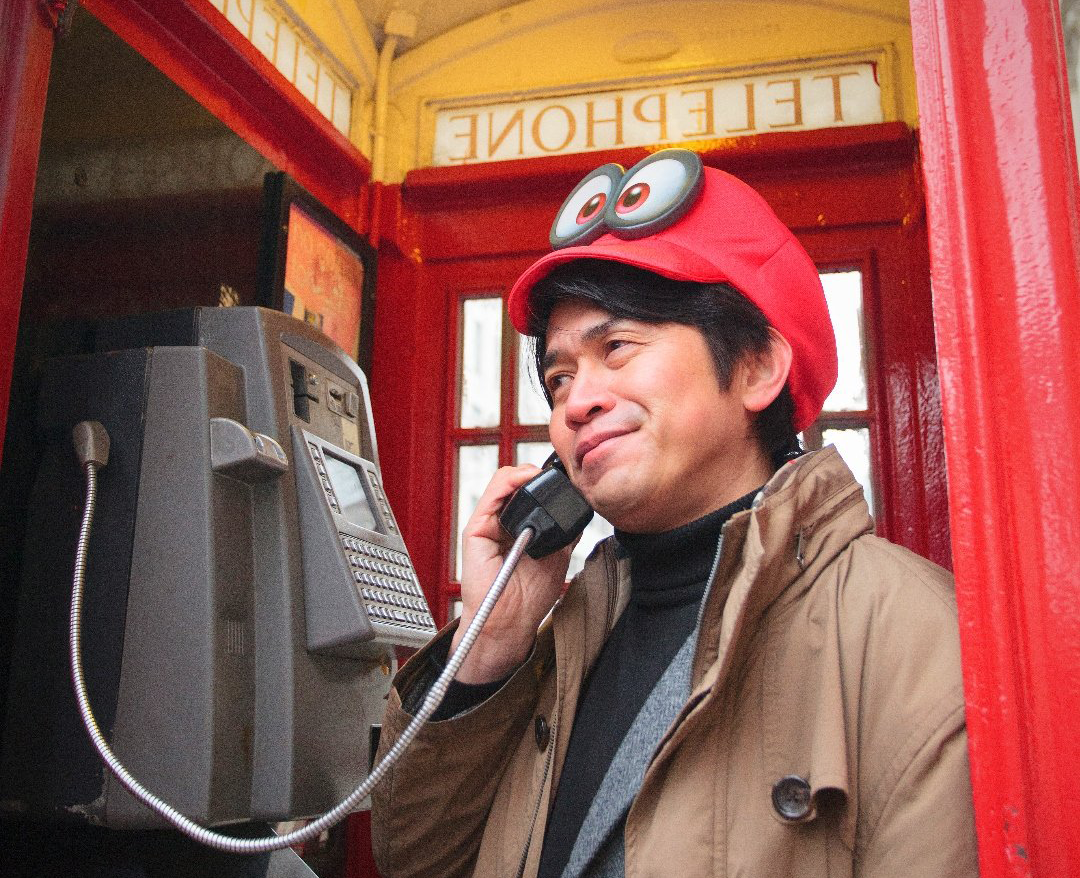
Way back in 2007, I wrote a profile of Yoshiaki Koizumi for N-Sider. At that time, Super Mario Galaxy was just about to launch all over the world. The game was a very powerful statement from Nintendo; here they were, taking perhaps their single biggest franchise character, and throwing him into a radically different context. This game looked like no other Mario game before it, with its unique spherical worlds and gravity physics.
In several respects, Super Mario Galaxy was the biggest leap forward for the loveable plumber since the revolutionary Super Mario 64. Even more remarkable was that Nintendo’s famed game designer Shigeru Miyamoto was not the director; instead, the job had gone to a younger and lesser-known figure, Yoshiaki Koizumi.
Like many of Nintendo’s senior designers, Koizumi had already been with the company for a long time and had undertaken many different roles (he had actually started life at Nintendo by working on the artwork in game manuals, where he was able to flesh out characters and build backstories which have since become legendary among Nintendo fans).
Since the year 2000 — and guided personally by Miyamoto — Koizumi has directed some of Nintendo’s most striking and innovative titles, including Donkey Kong Jungle Beat and Super Mario Galaxy. And since 2007, Koizumi has produced numerous hits including Super Mario Galaxy 2 and Super Mario 3D Land.
I am pleased to bring Koizumi’s story to you in an updated Developer Story for SUPERJUMP. Much of the original text remains unchanged, although I have made some amendments and additions, in an effort to increase the relevance of the story for today’s readers. I would like to thank Cory Faller of N-Sider for giving me permission to rework and republish my original story.
An unlikely candidate
Many of Nintendo’s early staff were programmers or had studied in disciplines related to computer hardware and software development. The exception was Shigeru Miyamoto, who was originally hired as the company’s first staff artist. Miyamoto transformed game development at Nintendo and brought new disciplines to bear on the process itself.
Yoshiaki Koizumi was similar to Miyamoto in several respects: he came from an art background (having studied film, drama and animation at the Osaka University of Arts) and had little exposure to the world of videogames prior to Nintendo (the first game he played was Super Mario Bros., which he played in college, despite the Famicom console launching when he was in sixth grade).
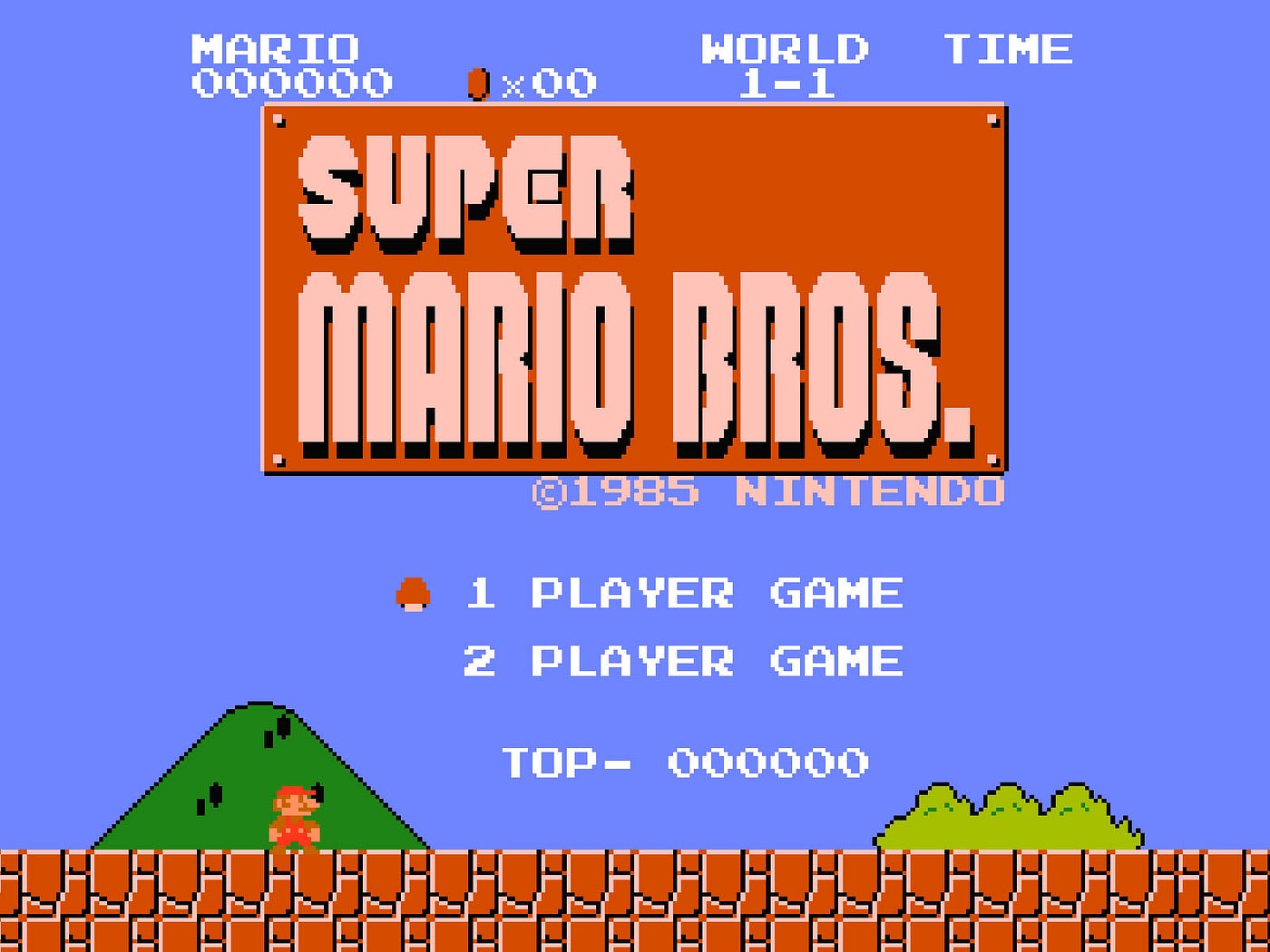
Ironically, Koizumi’s first gaming experience was not entirely positive. He found himself constantly dying in World 1–1 of Super Mario Bros. The game seemed difficult to Koizumi, primarily because it was so unforgiving; Mario died after only one hit. Instead, he preferred The Legend of Zelda, because it was possible to survive a little longer, with Link having three hearts at his disposal.
Koizumi joined Nintendo soon after graduating from Osaka University of Arts’ Visual Concept Planning Department. Although his ambition was to become a film director, he saw video games as a new form of dramatic expression; it would be possible, he thought, to create a unique kind of drama that could not be experienced through movies alone.
The first project that came Koizumi’s way was The Legend of Zelda: A Link to the Past for the SNES console. Far from being involved in development of the game itself, Koizumi was given a task that he was uniquely qualified for: he had to find a way to tie the game’s many complex gameplay elements together, through the creation of a cohesive narrative.
Nintendo’s games were always centred around gameplay experiences and story was considered to be largely secondary. When Koizumi joined the Zelda team, he discovered that the game contained many elements that had no relationship in particular (other than being relevant to gameplay). The key was to bring these elements together by giving them a reason to exist (and to be logically related to one another). This task resulted in the creation of many Zelda staples (including major story elements, such as the goddesses and the various symbols that represented them). In addition to contributing to Zelda’s storyline, Koizumi was also responsible for writing the game’s manual and putting together its artwork.
This process of tying gameplay elements together through a cohesive story has since developed into a particular area of design, known as “event design”. However, when Koizumi joined Nintendo, there were few games that required such attention. After contributing to these areas in A Link to the Past, Koizumi shouldered the vast majority of story development in The Legend of Zelda: Link’s Awakening on the GameBoy.

Koizumi often thought that games could be infused with more complex, detailed stories. He wanted characters to come alive through their interactions with each other, as well as their overall back-stories. As he was increasingly being given free license to develop these aspects, Koizumi attempted to inject more detail into his work. However, Nintendo’s EAD group were often not interested in the finer points of storytelling; to them, gameplay came first and the narrative was largely a function that brought overall cohesiveness to the project. Narrative supported gameplay, but was not a desirable end in and of itself.
As a result, Koizumi was told that story elements should not dominate the games; they should always play a supporting role. Koizumi responded to this by sneaking more detailed story elements under the radar. And this, in turn, gave birth to another element that permeated several Nintendo titles: rather than have too many narrative elements unfold in front of the player all the time, the player would be able to trigger titbits of story by either talking to non-player characters or simply “listening” to them have their own conversations. In this way, Koizumi could inject the game worlds with rich histories and detailed personalities, without constantly bombarding the player. In effect, the player would only ever reveal as much story as he or she wanted to, given that these elements needed to be physically activated during gameplay.
Later EAD titles, such as Ocarina of Time and Majora’s Mask were full of these “player-triggered story elements”. Koizumi has taken credit for this trend in Nintendo games since the SNES days, although he has acknowledged that Shigeru Miyamoto is not always pleased with his emphasis on story.
Solving the 3D problem
After working on both A Link to the Past and Link’s Awakening, Koizumi occupied prominent roles on subsequent titles such as Super Mario Kart and Super Mario World 2: Yoshi’s Island. The next great challenge in Koizumi’s career came when he was appointed as Assistant Director on what was perhaps the most important Nintendo title in the 1990s: Super Mario 64.
There were several reasons why anyone would feel intimidated as Assistant Director on such an important game. For one thing, Koizumi was working directly under Shigeru Miyamoto on a game that really put Miyamoto’s reputation to the test. As well, Super Mario 64 was, in almost every sense, a leap into the unknown; it was the game that had to legitimise the oft-delayed Nintendo 64 console. Not only did it have to be good, it had to be revolutionary.

Apart from the obviously astronomical expectations both inside and outside Nintendo, Super Mario 64 presented a serious design challenge. It was not just a question of bringing Mario into three dimensions; it was also a question of learning how to correctly develop a three-dimensional game in general. Super Mario 64 would provide a critical foundation for all of Nintendo’s future 3D work. Luckily, Koizumi already had experience with 3D graphics, as he had produced several examples in his own time during his college years. This experience gave him a solid background for early Nintendo 64 projects.
The highly daunting project began in the humblest of ways. The first step simply involved the creation of a three-dimensional model of Mario. Koizumi produced a model, to which he added basic textures and animation. Initial critical details involved making Mario walk, run and jump. Shigeru Miyamoto considered these simple actions to be fundamental to the entire experience and Yoshiaki Koizumi often found himself discussing the specific details of Mario’s simplest manoeuvres until 1 or 2am in the morning.
Once 3D movement had been essentially solved, there was a potentially bigger problem on the horizon; what is the best way to view the game world?
Koizumi was deeply involved with solving this problem in Super Mario 64. Both he and Miyamoto brainstormed on the best way to view Mario in a three-dimensional world. There were many options; the camera could always sit to the side of Mario (much like a traditional 2D game, which would stop players from getting lost or disoriented) or the camera could follow Mario around dynamically (the “over the shoulder” or “follow cam” approach that Super Mario 64 and latter Nintendo games adopted). In the end it was decided that a follow camera would give players the ideal view. It was a camera system that could be either manually adjusted by the player, or it could be set to follow Mario automatically.
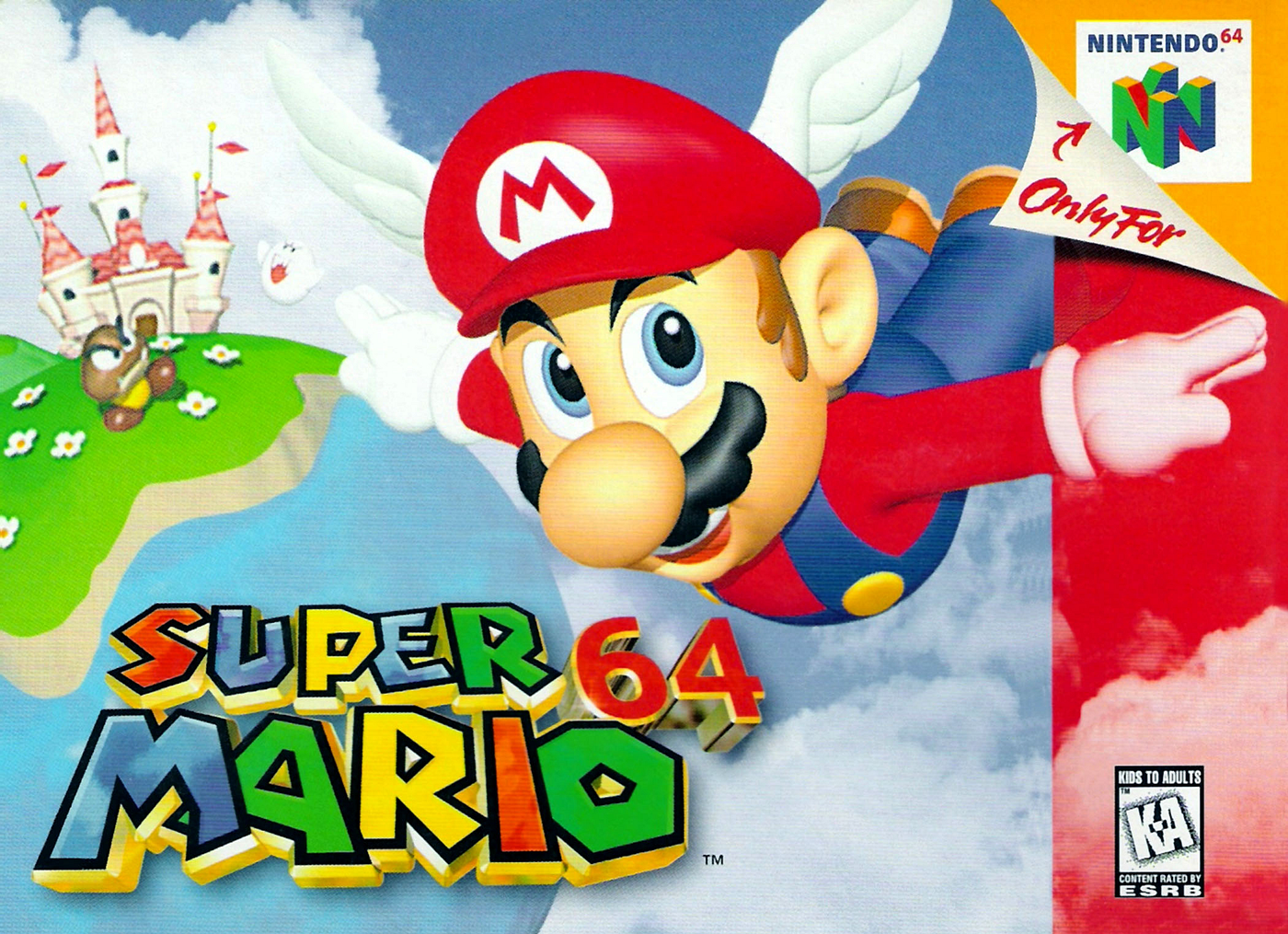
Super Mario 64 was released to universal critical acclaim. Not only had it successfully brought Mario into the brave new world of 3D gaming; it had set a clear standard for the entire industry. Super Mario 64 became a lesson to other developers (and to Nintendo itself) about how to approach a 3D space. Ironically, several developers in Japan had stated that 3D games were “impossible” only a few short years earlier. Super Mario 64 made believers of anyone who doubted Nintendo EAD’s talents. And Yoshiaki Koizumi was very much at the centre of the revolution.
Later EAD games built on Super Mario 64’s foundation. In both The Legend of Zelda: Ocarina of Time and Majora’s Mask, the 3D camera system had further evolved. In particular, Nintendo had solved the problem of depth perception; Link was now able to target enemies, which prevented the player from having to deal with a cumbersome manual system.
In addition to further advances in camera control, Koizumi and company pursued game environments that were “like a movie you could touch”. The Legend of Zelda: Ocarina of Time introduced a natural day/night system that, Koizumi believed, added a further layer of immersion to the world.
A chance to lead
Koizumi had quickly become a highly successful, creative member of the EAD group. He had proven himself to be versatile, innovative and a true problem-solver. This led to him being appointed as Director on Nintendo’s next major Mario title, Super Mario Sunshine.
Super Mario Sunshine was a radical departure for the series in some respects. For one thing, it was set in a completely new locale: a tropical paradise full of water and water-based environmental obstacles. The water theme followed through to a major gameplay addition in the form of Mario’s FLUDD jetpack, which gave him multiple new abilities (including the ability to hover for short periods, “ski” at high speed along bodies of water, boost himself high into the air and spray water at enemies and objects).
“When I submitted the basic proposal for the game to Mr. Miyamoto, I had already come up with the water-pistol idea. I tried to explain how the analogue stick could make players feel the touch of a water pistol.
Letting Mario have a water pistol alone wouldn’t make the game fun. I started thinking about the best way to feature the water pistol, how Mario should move and show the water pistol. I liked the basic play control style of Super Mario 64 and thought that it should be applied to the new game.
I tried to imagine what Mario would be like on the Nintendo GameCube, and, from the very beginning, I let him have a water pistol. This is where I started. Then, I built upon that to imagine why Mario might have a water pistol; what kind of actions he would have. Then we came up with the graffiti-like elements.”
Yoshiaki Koizumi
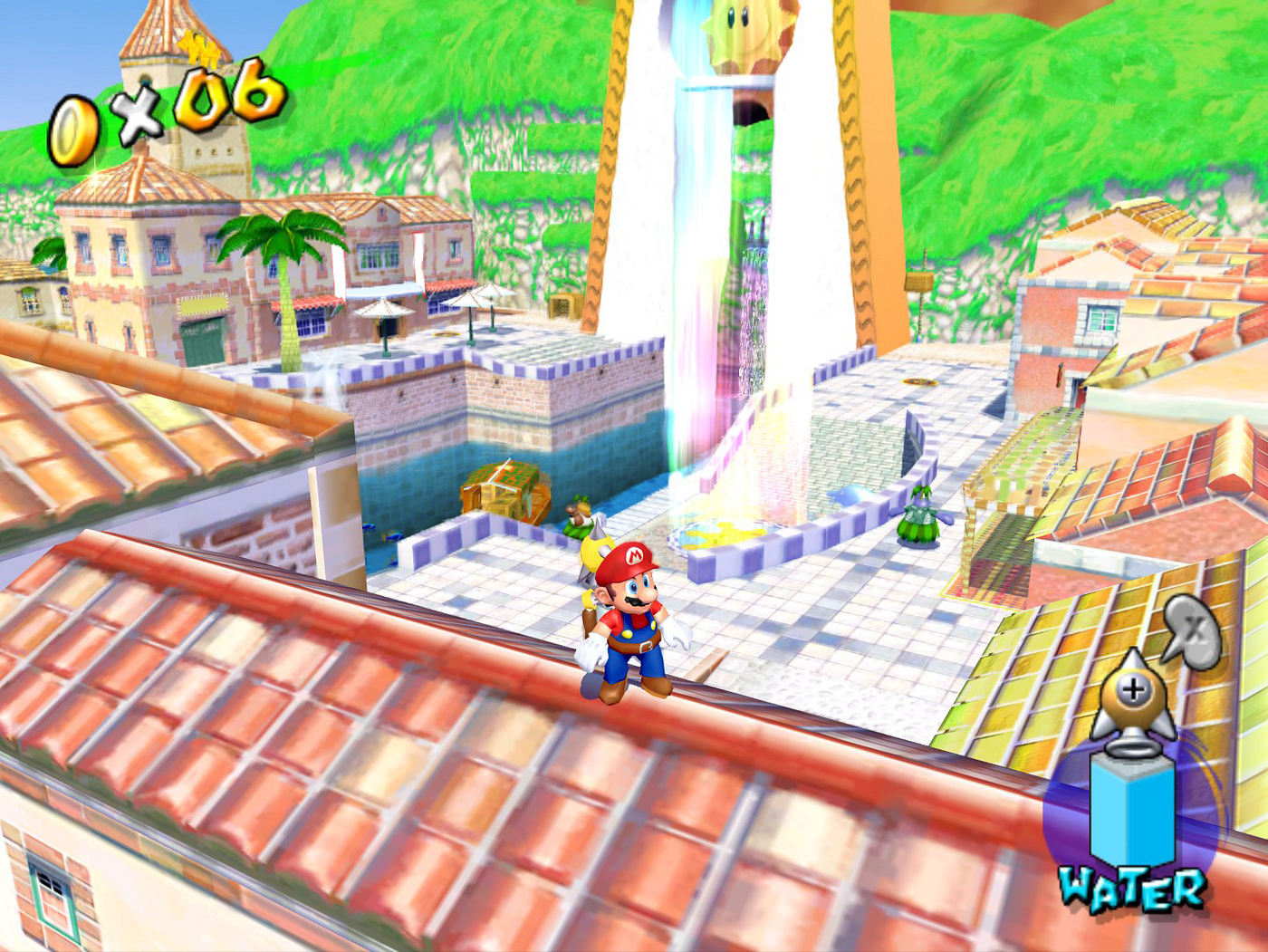
The follow-up to Super Mario 64 was an attempt to expand upon its predecessor in several meaningful ways. The locale, which seemed somewhat random to gamers, was actually based on the idea of a “miniature garden” (little gardens in boxes, found in Japan). Koizumi’s team incorporated the FLUDD jetpack for several reasons, too. Apart from simply giving Mario more moves, Koizumi believed that it would help with common confusion surrounding depth perception and spatial ambiguity (having shadows cast underneath Mario also helped a great deal).
In addition, Koizumi wondered why Mario had to be limited to simply running and jumping. Mario had effectively mastered jumping on enemies, so why couldn’t a game be made where simply running around and exploring would also be fun?
Super Mario Sunshine’s environments were created with this concept in mind. The emphasis on jumping was reduced in favor of exploration and environmental interaction. Now, Mario could spray water at enemies and he could also realistically spray paint off objects, which would act to modify his surroundings and surprise the player.
“What are important in games are their feel and touch. What I really wanted to reproduce with this new game were the feelings we had in our childhoods when we were playing. The water pistol idea came from this effort. I wanted players to feel the coldness of water. I wanted players to engage in mischief, such as watering other characters or playing with mud. I wanted to simulate child’s play. That was the first priority.”
Yoshiaki Koizumi
Also, Super Mario Sunshine attempted to introduce more complex 3D environments without the need for an in-game map. This was achieved by deliberately placing clear landmarks in levels, which players could use as visual cues without needing to stop what they were doing.
Super Mario Sunshine received highly positive reviews and was generally a critically-acclaimed title. At the very least, it was one of the better platform games of its time. However, many Nintendo fans considered that it didn’t go far enough; it wasn’t new enough for Mario fans in particular. The decidedly “un-Mario” setting, combined with a slightly more divergent style of gameplay was not what many were expecting in a “true” sequel to Super Mario 64. To this day, Super Mario Sunshine is often considered to be a black sheep in the Mario family.

Three-dimensional game design was a difficult process and it brought about several different philosophies. Koizumi felt that 3D games — and their accessibility — were often defined by both camera control and the inherent limitations of a 3D world. On the one hand, there were games with completely automatic cameras. These were probably the ideal solution, but it was virtually impossible to create a camera that would sit in the ideal position 100% of the time. The obvious solution was to introduce a manually controlled camera; this, too, brought about problems. Koizumi felt that when the player had to control both the camera and their character simultaneously, gameplay became too difficult for some players. Ultimately, Koizumi thought that gamers could probably be divided into these two camps.
Another problem with 3D games, according to Koizumi, was that the worlds were finite. In other words, if players ran far enough they would inevitably hit an “invisible wall”. This would often trigger a violent camera change and a jarring break from fluid gameplay. Koizumi considered this phenomenon to be a major problem in modern 3D games.
This conclusion brought Koizumi to a clear crossroads: how should 3D Mario games behave in the future? For the time being, the answer was unclear and Koizumi decided to take a break from Mario projects.
Between dimensions
In 2003, Koizumi began working out of Nintendo’s new Tokyo offices. EAD Tokyo consisted of several experienced staff that had moved down from Kyoto, but it also took in an influx of new staff from around the city. The end result was a young team, full of energy and enthusiasm, with several experienced staff carefully guiding them.
Koizumi began drafting an idea for a new game: Donkey Kong Jungle Beat. This game, despite having three-dimensional graphics, immediately solved the issues that had been encountered with Super Mario Sunshine. The gameplay unfolded on a two-dimensional plane, which left the designers to concentrate purely on level design and user interaction.

It was in the latter area that Jungle Beat was different than anything Nintendo had produced before; it utilised the GameCube’s bongo drum controller for character movement. Players had to strike the drums to make Donkey Kong run left or right and to jump. Donkey Kong jumped by hitting both drums simultaneously and he attacked enemies by clapping (which was interpreted by an in-built microphone).
There were several areas where Jungle Beat was different. First of all, the game essentially contained two “modes” of play: most gameplay involved a side-on camera view with Donkey Kong navigating a lush, vivid world full of traps and obstacles. Additionally, when players struck certain enemies by clapping, the game would move to a different “combat view”, where the bongo controls became dedicated entirely to combat rather than movement. This system was known as “contextual binding” and it allowed the game to feature multiple actions using essentially three buttons.
As well as the raw gameplay innovations, Jungle Beat featured an “over the top” style that (according to Koizumi) deliberately encouraged players to hit things.
Donkey Kong Jungle Beat was a game that allowed Koizumi to get back to his core ideas about ease of play and overall accessibility. The game managed to feel fresh and new while simultaneously being incredibly easy for anyone — veteran gamer or not — to get into. Furthermore, Koizumi felt that Jungle Beat was fun to watch; families often commented that watching each other play the game was almost as fun as being the player. Jungle Beat exemplified many of Koizumi’s deeply-held philosophies about how an ideal game should be designed.
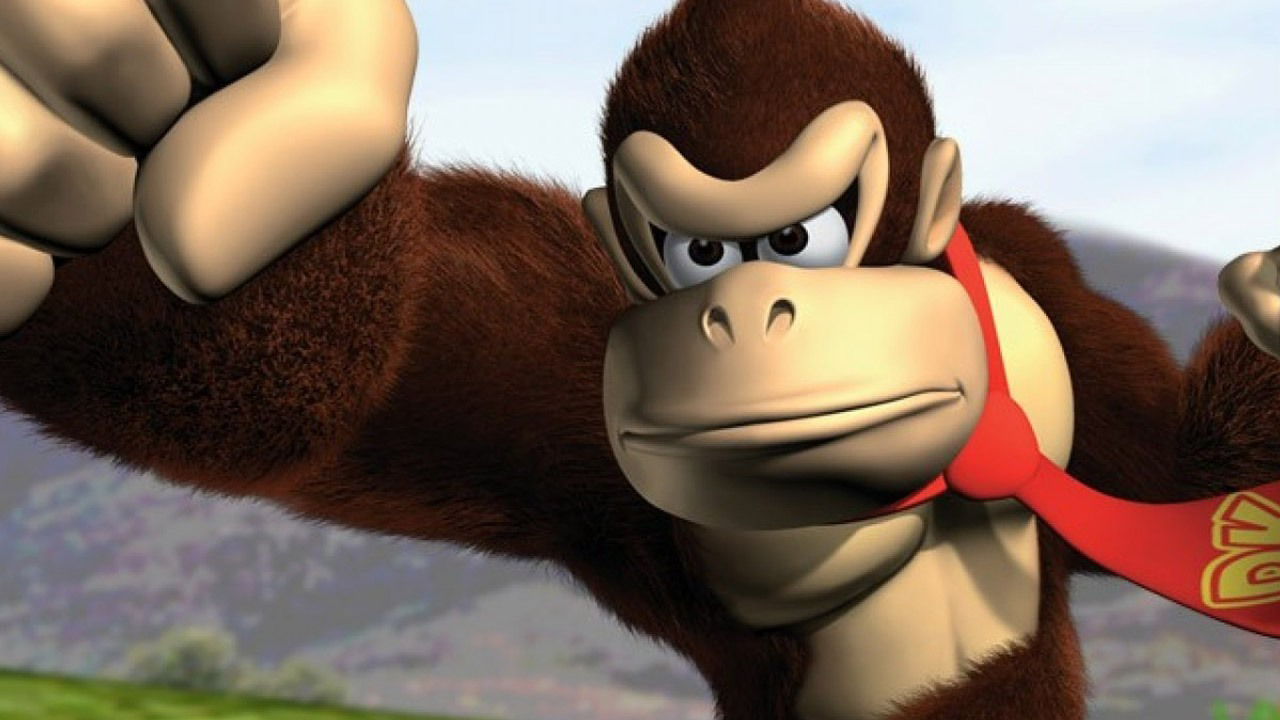
At the end of the project, the EAD Tokyo team decided that one of their main goals was to positively engage entire families with their games. It was not just about accessibility for the player, it was also about making the console more acceptable to the entire family.
“Jungle Beat turned out to be a really remarkable game, even just by the appearance of someone playing it. I aimed to create a game that would make even bystanders giggle and enjoy themselves.”
Yoshiaki Koizumi
Koizumi had learned many lessons at this point, with Super Mario Sunshine and Donkey Kong Jungle Beat either confirming or confronting his key ideas about game design. This experience led Koizumi and his team into a new era, as both a revolutionary console (and perhaps an equally revolutionary new software project) appeared on the horizon.
Skipping across the stratosphere
Having just completed Super Mario Sunshine and Donkey Kong Jungle Beat, Koizumi and his team were looking for the next challenge. When the team began working with GameCube’s successor — the Wii — they decided to attempt another Mario title.
Both Koizumi and Miyamoto wanted to incorporate recent lessons into their next project (originally dubbed “Super Mario Revolutions”). With Koizumi’s two previous projects, he had attempted to tackle the ever-present issues of camera control and limitations with 3D environment design.
It was at this point that both Koizumi and Miyamoto agreed on a single proposal: spherical worlds.

Spherical worlds were not new to Nintendo. When Miyamoto had revealed several technical demonstrations for GameCube years earlier, he had unveiled the initial concept for spherical environments. At that time the demo was not planned for a specific game, but like many Nintendo experiments, it was revisited years later and utilised in an actual project.
On the surface, spherical worlds solved a number of problems. For one thing, these environments had no real end; Mario could continue running around endlessly and never hit a wall. Koizumi recently pointed out that no matter how large you make a game world, the player will eventually hit an “invisible wall”, which will interfere with gameplay.
In addition, spherical worlds would also theoretically solve problematic cameras. With a spherical world, it would be much easier to place the camera in a position where it could always see the player and provide the ideal angle, without the need for the player to constantly intervene. A further benefit was that Mario would be able to walk upside down, on walls or on any side of the planet without the player becoming disoriented; the character would essentially remain in the middle of the screen no matter what, avoiding jarring camera angle changes. It was also considered that this assisted with motion sickness problems in some players.
Koizumi and team also incorporated a two player mode into the game, which hadn’t been seen since the SNES Mario titles. Although Koizumi considered the option of allowing two players to control their own characters at once, he believed that this would ultimately be too difficult to implement — especially if the players decided to run in opposite directions.
Instead, a cooperative system was included, which allowed the second player to pick up a Wii Remote and assist (or hinder) the first player. Koizumi felt that this system would encourage family members to join in on the game, even if they were not directly controlling Mario.
As with past games, Koizumi was keen to incorporate story elements. Mario titles in particular were known for being light on story and Koizumi felt that including any story in particular would be frowned upon by Miyamoto. His solution was to include an in-game story book that players could access at their leisure. This way, if they wanted story they could choose to follow it or alternatively, they could simply play the game and avoid its story almost entirely.
Super Mario Galaxy also further cemented the working relationship between Koizumi and Miyamoto. Koizumi, as the game’s director, was responsible for coming up with the primary solutions and the “broad strokes” of the game’s design. Miyamoto was someone Koizumi could go to for approval of specific ideas or for general advice. Miyamoto also regularly provided feedback to Koizumi and his team.
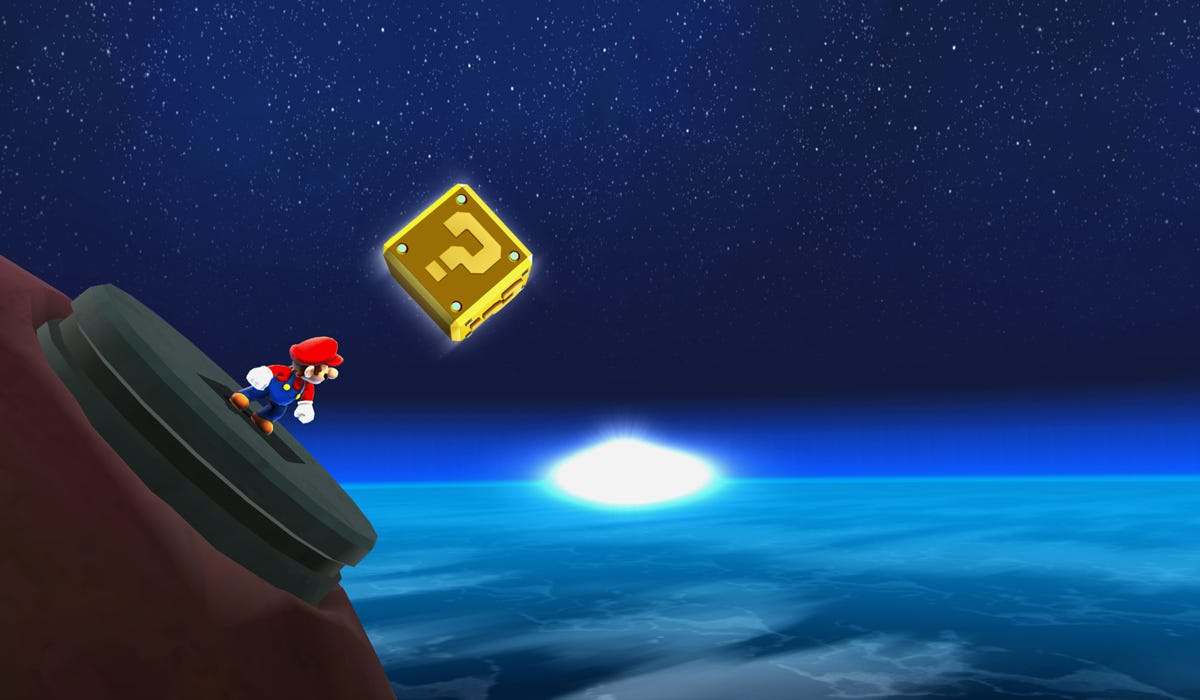
Koizumi, perhaps more than most EAD designers, had to become fully acquainted with Miyamoto’s style of working. Miyamoto often confused staff in his emails, either because his comments were cryptic and unspecific or because they lacked context. Koizumi was regularly in the position of clarifying Miyamoto’s thoughts to his team, or correctly interpreting the meaning of his messages. Moreover, Miyamoto rarely offered outright solutions or direct suggestions to Koizumi and team; instead, he would make a suggestion or simply ask a vague question. The idea, Koizumi believed, was to encourage the team to find their own solutions without needing to be told specific details.
“It seems like Miyamoto has a reason for this level of abstraction. I feel like he’s making us work to solve these puzzles on purpose, because it’s a process that unlocks the creativity on our side. So even though Miyamoto might have some unformed ideas, the very fact that he would put all these challenges in front of us makes me feel very grateful, because it helps the process.”
Yoshiaki Koizumi
Super Mario Galaxy differed from its 3D predecessors in one other important way: it was, to some degree, more linear. Rather than dropping Mario into an enormous world and including multiple stars in the same general space, Super Mario Galaxy adopted a more “modular” design. Koizumi felt that it would be easier to incorporate multiple flight paths, which would distinctly separate each particular goal. In this way, the player can continually re-visit a world without frequently traversing the same landscape to reach new goals.
Upon release, Super Mario Galaxy was hailed by many as not only the greatest Wii title, but also the greatest 3D platformer of all time. Praise was almost universal for the game and the sales reflected it (the game went on to sell more than 12.5 million copies globally by late 2015).
A master in the making
Yoshiaki Koizumi had well and truly earned his stripes by the time Super Mario Galaxy launched. Having occupied numerous roles throughout his career at Nintendo (illustrator, CG designer, animator, character and event design, director, and many others), it was time for Koizumi to earn the title that even Miyamoto had dreamed of during his early career: Producer.
As a producer at Nintendo, Koizumi’s responsibility further expanded. He oversaw development of titles such as Super Mario Galaxy 2, Donkey Kong Country Returns, Super Mario 3D Land, and Super Mario 3D World. He also supervised and contributed to a number of other major projects including The Legend of Zelda: Skyward Sword and Captain Toad: Treasure Tracker.
Being a producer at Nintendo is not just about carrying responsibility for some of the biggest titles in video games; producers are vitally important mentors, helping to foster new generations of talent within the company. In the same way that Koizumi was mentored by Miyamoto, other designers have been guided by Koizumi. A particularly notable example is Koichi Hayashida, who is now one of Nintendo’s most senior game design figures, having directed Super Mario Galaxy 2, Super Mario 3D Land, and Super Mario 3D World.
In late 2015, following the appointment of Nintendo’s new president, Tatusmi Kimishima, the company announced a major restructure. Koizumi was appointed as Deputy General Manager for the newly-created Entertainment Planning & Development division (the result of a merger between Nintendo’s Entertainment Analysis & Development and Software Planning and Development divisions).
As of September 2015, Entertainment Planning & Development is Nintendo’s largest divison.

At the time of publishing, Nintendo is entering a bold new phase in its more than 120 years in operation, having just launched its first iOS and Android title Miitomo. It is also gearing up for the expected announcement of its next-generation game console (codenamed NX) at some point in 2016.
Whatever Nintendo pursues next, the key to its success will no doubt continue to be its ability to create fun and delightful experiences. Yoshiaki Koizumi will be a key player in the company’s next steps, and his leadership will influence Nintendo’s games for many years to come.
“I’m sure some of you here are on a journey right now, or getting ready to start one. Please — enjoy the journey. Believe firmly that games that are fun to make are always fun to play when they reach the consumer.
Yoshiaki Koizumi
